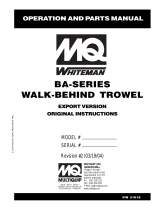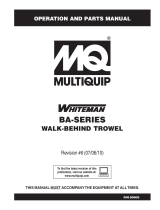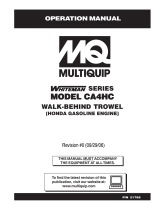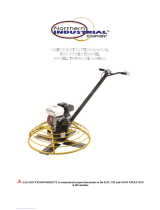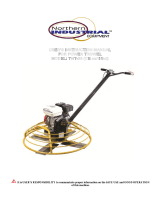
PAGE 18 — JTN RIDE-ON TROWEL— OPERATION & PARTS MANUAL — REV. #5 (08/03/067)
JTN RIDE-ON TROWEL — GENERAL INFORMATION
JTN RIDE-ON TROWEL FAMILIARIZATION
The JTN ride-on trowel is designed for the floating and finishing
of concrete slabs. This ride-on trowel is a non-overlapping trowel.
Take a walk around the trowel. Take notice of all the major
components (see Figures 5 and 6) like the engine, blades, air
cleaner, fuel system, fuel shut-off valve, ignition switch etc. Check
that there is always oil in the engine, and gear oil in the gear box
assembly.
Read all the safety instructions carefully. Safety instructions will
be found throughout this manual and on the machine. Keep all
safety information in good, readable condition. Operators should
be well trained on the operation and maintenance of the trowel.
Look at the operator control levers. Grab the control levers and
move them around a bit. Look to see how moving the control
levers causes the gearboxes and frame to move.
Notice the foot pedal which controls the engine speed. Also take
a look at the main driveline of the trowel. Take note and reference
how the belts look, this is the way the belts should look when
adjusted properly.
Before using your ride-on trowel, test it on a flat watered down
section of finished concrete. This trial test run will increase your
confidence in using the trowel and at the same time it will
familiarize you with the trowel’s controls and indicators. In addition
you will understand how the trowel will handle under actual
conditions.
Engine
This trowel is equipped with either a air-cooled 18 HP Vanguard
(Briggs and Stratton) gasoline engine or a 20 HP air-cooled
Honda gasoline engine (GX620). Refer to the engine owner’s
manual for specific instructions regarding engine operation. This
manual is included with the ride-on trowel at the time of shipping
from Whiteman. Please contact your nearest Multiquip Dealer
for a replacement should the original manual disappear.
Blades
The blades of the trowel finish the concrete as they are rotated
around the surface. Blades are classified as
combination
(8 inches wide),
float
(10 or 8 inches wide), and finish (6
inches wide). This trowel comes equipped with four blades
per rotor equally spaced in a radial pattern and attached to
vertical rotating shaft by means of a
spider assembly.
Gearboxes
The JTN ride-on trowel consist of two separate gearbox
assemblies that are enclosed in rugged cast aluminum gear
cases. The main gear is a high quality bronze and steel
composite. The worm gear is composed of hardened steel.
Cooling fins and fans are integrated into the gearbox to provide
maximum cooling for the gearbox oil. The gearbox casing holds
50% more oil capacity than competitors, which allows more
lubrication to be provided to critical points.
Steering Assist
Dual control levers located in front of the operator's seat are
provided for steering the trowel. The control levers are linked to
two spring loaded cylinders. Push the left control lever forward
and pull the right control lever backward and the trowel will rotate
clockwise on approximately a center axis. Pull the left control
lever backward and push the right control lever forward and the
trowel will rotate counterclockwise. See Table 4 for a complete
description on the control levers directional positioning.
Constant Velocity Joints (CV-Joints)
Constant velocity joints insure the efficient transfer of power to
the drive shaft and maintains the timing of the gearboxes without
any chance of slippage.
Training
For proper training, please use the “TRAINING CHECKLIST”
located in the front of this manual. This checklist will provide an
outline for an experienced operator to provide training to a new
operator.























